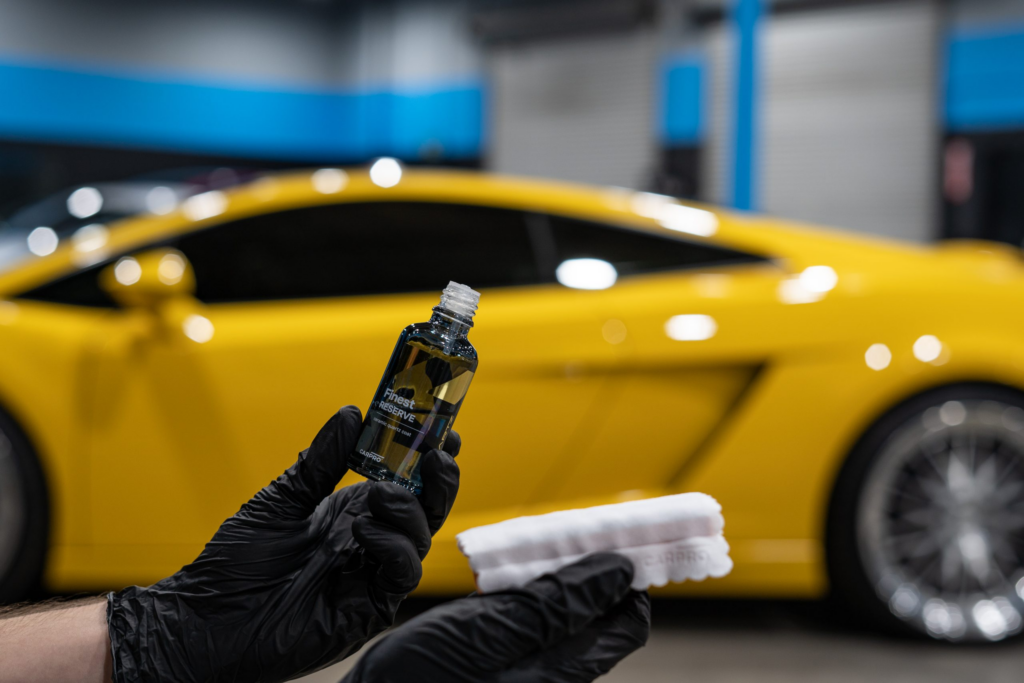Wax vs Ceramic Coating
Maintaining your vehicle’s exterior is essential not only for aesthetic appeal but also for preserving its value and longevity. Two primary methods of paint protection are traditional car wax and modern ceramic coatings. Understanding the differences between these options is crucial for making an informed decision that aligns with your vehicle care goals.
What is Car Wax?

Car wax has been a staple in automotive care for decades. It provides a protective layer over the vehicle’s paint, enhancing shine and offering a degree of protection against environmental elements.
Types of Car Wax:
- Natural Wax: Derived from natural sources like carnauba, natural waxes are renowned for their deep, warm glow. However, they typically have a shorter lifespan, often requiring reapplication every few weeks.
- Synthetic Wax: Formulated from polymers or acrylics, synthetic waxes offer longer-lasting protection compared to natural waxes, sometimes extending up to a few months. They provide a high-gloss finish and are generally easier to apply.
- Spray Wax: Designed for quick application, spray waxes are convenient for touch-ups and maintaining shine between more thorough waxing sessions. However, their protective qualities are often less robust and shorter-lived.
Benefits of Waxing:
- Enhanced Shine: Waxing imparts a glossy finish, enriching the vehicle’s color and depth.
- Water Beading: A freshly waxed surface promotes water beading, aiding in the runoff of rainwater and reducing water spots.
- UV Protection: Waxes provide a barrier against harmful UV rays, helping to prevent paint oxidation and fading.
Limitations of Waxing:
- Short Lifespan: Most waxes, especially natural ones, wear off relatively quickly, necessitating frequent reapplication.
- Limited Durability: Wax coatings are susceptible to degradation from environmental contaminants, harsh weather, and regular washing.
- Time-Consuming Maintenance: Regular waxing requires a consistent time investment to maintain optimal protection and appearance.
What is Ceramic Coating?
Ceramic coating is a liquid polymer applied to a vehicle’s exterior surfaces, chemically bonding with the factory paint to form a durable, protective layer. This advanced technology offers superior protection compared to traditional waxing methods.
Benefits of Ceramic Coating:
- Long-Lasting Protection: High-quality ceramic coatings can last several years, significantly outlasting traditional waxes.
- Hydrophobic Properties: Ceramic coatings create a water-repellent surface, causing water to bead and slide off easily, which simplifies cleaning and reduces water spots.
- Enhanced Resistance: They offer robust protection against environmental contaminants, UV rays, and minor scratches, preserving the vehicle’s paintwork.
Professional vs. DIY Application:
- Professional Application: Involves meticulous preparation and application by trained technicians, ensuring optimal bonding and performance. While more expensive, it often comes with warranties and guarantees.
- DIY Application: More affordable and convenient, DIY kits are available for enthusiasts. However, achieving professional-level results requires careful preparation, attention to detail, and adherence to application instructions.
Ceramic Coating vs. Wax: Head-to-Head Comparison
- Durability: Ceramic coatings provide long-term protection, often lasting years, whereas waxes typically last only weeks.
- Protection: Ceramic coatings offer superior resistance to contaminants, UV rays, and minor scratches compared to wax.
- Cost-Effectiveness: Despite a higher initial cost, ceramic coatings can lead to long-term savings by reducing the frequency of reapplications.
- Aesthetic Appeal: Both options enhance a vehicle’s appearance, but ceramic coatings maintain a glossy finish for a longer period.
- Maintenance: Vehicles with ceramic coatings are easier to clean and require less frequent applications than those protected with wax.
Common Myths About Ceramic Coating
- “Ceramic coating is just an expensive wax”: Unlike wax, ceramic coatings chemically bond with the paint, offering a more durable and long-lasting protective layer.
- “It makes the car scratch-proof”: Ceramic coatings provide resistance to minor scratches but do not make the vehicle entirely scratch-proof.
- “DIY ceramic coating is as good as professional application”: While DIY kits are available, professional applications typically ensure better preparation, application, and overall results.
Why Ceramic Coating is the Best Choice
- Long-Term Protection and Investment: Ceramic coatings offer extended protection, preserving the vehicle’s appearance and value over time.
- Minimal Maintenance for Maximum Shine: The hydrophobic properties make cleaning easier, maintaining a high-gloss finish with less effort.
- Cost-Effective Compared to Repeated Waxing: The longevity of ceramic coatings reduces the need for frequent waxing, leading to cost savings in the long run.
How to Get Ceramic Coating for Your Car

- DIY vs. Professional Installation: Consider your skill level, tools, and environment when deciding between a DIY application and professional service.
- Choosing the Best Ceramic Coating Service: Research reputable providers, read reviews, and consult with professionals to ensure quality service.
- Booking an Appointment with Precision Coatings Detailing: For top-tier ceramic coating services, consider scheduling an appointment with Precision Coatings Detailing.
Conclusion
In conclusion, while traditional car wax offers certain benefits, ceramic coating stands out as a superior option for long-term vehicle protection. Its durability, enhanced protection, and reduced maintenance make it a worthwhile investment for car owners. To experience these benefits firsthand, consider making the switch to ceramic coating. Book a service with Precision Coatings Detailing today to protect and enhance your vehicle’s appearance.
